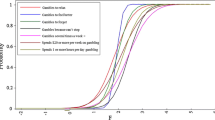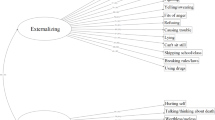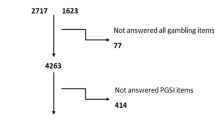Abstract
The primary purpose of this study was to determine the individual, family, and peer factors that correlate with adolescent gambling. High school students from three states (N = 1,846) completed an anonymous questionnaire assessing the behavior of themselves, their parents, and their peers. Participants also reported on their gambling behavior via the SOGS-RA, which was used to create five adolescent gambling groups (i.e., Non-Gamblers, Non-Problem Gamblers, At-Risk Gamblers, Problem Gamblers, and Probable Pathological Gamblers). In a discriminant function analysis using demographic, individual, family, and peer factors as potential discriminators, two functions emerged that accounted for 94% of the variance between groups. The first function was linear, with the Probable Pathological Gamblers reporting the highest level of peer and parent gambling, susceptibility to peer pressure, conduct problems, binge drinking, suicide attempts, drug use, and being male. The second function highlighted three unique qualities of individuals in the two outlying groups: Probable Pathological Gamblers and Non-Gamblers. These findings suggest that demographic, individual, family, and peer variables are all important correlates of probable pathological gambling in adolescents. Results also support the utility of a five-group classification scheme based on the SOGS-RA. The clinical implications of these results are discussed.
Similar content being viewed by others
References
American Psychiatric Association (APA) (1994). Diagnostic and Statistical Manual of Mental Disorders (4thedition.). Washington, DC: APA.
Derevensky, J. L., & Gupta, R. (2000). Prevalence estimates of adolescent gambling: A comparison of the SOGS-RA, DSM-IV-J, and the GA 20 questions. Journal of Gambling Studies, 16(2/3), 227-251.
Derevensky, J. L., Gupta, R., & Cioppa, G. D. (1996). A developmental perspective of gambling behavior in children and adolescents. Journal of Gambling Studies, 12, 49-66.
Dielman, T. E., Butchart, A. T., & Shope, J. T. (1993). Structural equation model tests of patterns of family interaction, peer alcohol use, and intra-personal predictors of adolescent alcohol use and misuse. Journal of Drug Education, 23, 273-316.
Eysenck, S. B., & Eysenck, H. J. (1977). The place of impulsiveness in a dimensional system of personality description. British Journal of Social and Clinical Psychology, 16, 57-68.
Govoni, R., Rupcich, N., & Frisch, G. R. (1996). Gambling behavior of adolescent gamblers. Journal of Gambling Studies, 12, 305-317.
Griffiths, M., & Wood, R. T. A. (2000). Risk factors in adolescence: The case of gambling, videogame playing, and the Internet. Journal of Gambling Studies, 16(2/3), 199-225.
Gupta, R., & Derevensky, J. L. (1998). An empirical examination of Jacobs' General Theory of Addictions: Do adolescent gamblers fit the theory? Journal of Gambling Studies, 14, 17-49.
Jackson, D. N. (1976). Jackson Personality Inventory Manual. Port Huron, MI: Research Psychologists Press.
Jacobs, D. F. (1989). Illegal and undocumented: A review of teenage gambling and the plight of children of problem gamblers in America. In H. J. Shaffer, S. Stein, B. Gambino, & T. Cummings (Eds.), Compulsive gambling: Theory, research, and practice (pp. 249-292). Lexington, MA: Lexington Books.
Jacobs, D. F. (2000). Juvenile gambling in North America: An analysis of long-term trends and future prospects. Journal of Gambling Studies, 16, 119-152.
Jacobs, D. F., Marston, A. R., Singer, R. D., Widaman, K., Little, T., & Veizades, J. (1989). Children of problem gamblers. Journal of Gambling Behavior, 5, 261-268.
Jessor, R. (1998). New Perspectives on Adolescent Risk Behavior. Cambridge, UK: Cambridge University Press.
Johnston, L. D., O'Malley, P. M., & Bachman, J. G. (1993). National survey results on drug use from monitoring the future study, 1975–1992. NIH Publication 93-3597. Washington, DC: US Government Printing Office.
Ladouceur, R., Boudreault, N., Jacques, C., & Vitaro, F. (1999). Pathological gambling and related problems among adolescents. Journal of Child and Adolescent Substance Abuse, 8, 55-68.
Ladouceur, R., & Dube, D. (1994). Gambling among primary school students in the Quebec Metropolitan area. Journal of Gambling Studies, 10, 363-370.
Ladouceur, R., Dube, D., & Bujold, A. (1994). Prevalence of pathological gambling and related problems among college students in the Quebec metropolitan area. Canadian Journal of Psychiatry, 39, 289-293.
Langhinrichsen-Rohling, J., Rohling, M., Rohde, P., & Seeley, J. (in press). The SOGS-RA versus the MAGS-7: Variations in adolescent gambling prevalence rates as a function of measurement device and geographic location. Journal of Gambling Studies.
Lesieur, H. R., & Blume, S. B. (1987). The South Oaks Gambling Screen (SOGS): A new instrument for the identification of pathological gamblers. American Journal of Psychiatry, 144, 1184-1188.
Lesieur, H. R., & Klein, R. (1987). Pathological gambling among high school students. Addictive Behaviors, 12, 129-135.
National Research Council. (1999). Pathological gambling: A critical review. Washington, DC: National Academy Press.
Radloff, L. S. (1977). The CES-D Scale: A self-report depression scale for research in the general population. Applied Psychological Measurement, 1, 385-401.
Roberts, R. E., Lewinsohn, P. M., & Seeley, J. R. (1991). Screening for adolescent depression: A comparison of depression scales. Journal of the American Academy of Child and Adolescent Psychiatry, 30, 58-66.
Rohde, P., Lewinsohn, P. M., Seeley, J. R., & Langhinrichsen-Rohling, J. (1996). The Life Attitudes Schedule Short Form: An abbreviated measure of life-enhancing and life-threatening behaviors in adolescents. Suicide and Life-Threatening Behavior, 26, 272-282.
Shaffer, H. J., & Hall, M. N. (1996). Estimating the prevalence of adolescent gambling disorders: A quantitative synthesis and guide toward standard gambling nomenclature. Journal of Gambling Studies, 12, 193-214.
Shaffer, H. J., Hall, M. N., & Vander Bilt, J. (1997). Estimating the prevalence of disordered gambling in the United States and Canada: A meta-analysis. Project funded by the National Center for Responsible Gambling. Kansas City, MO.
Shaffer, H. J., LaBrie, R., Scanlan, K. M., & Cummings, T. N. (1994). Pathological gambling among adolescents: Massachusetts Adolescent Gambling Screen (MAGS). Journal of Gambling Studies, 10, 339-362.
Stinchfield, R. (2000). Gambling and correlates of gambling among Minnesota public school students. Journal of Gambling Studies, 16, 153-173.
Stinchfield, R., Cassuto, N., Winters, K., & Latimer, W. (1997). Prevalence of gambling among Minnesota public school students in 1992 and 1995. Journal of Gambling Studies, 13, 25-48.
Stinchfield, R., & Winters, K. (1998). Gambling and problem gambling among youth. Annals of the American Academy of Political and Social Science, 556, 172-185.
Vitaro, F., Ferland, F., Jacques, C., & Ladouceur, R. (1998). Gambling, substance use, and impulsivity during adolescence. Psychology of Addictive Behaviors, 12, 185-194.
Winters, K. C., & Anderson, N. (2000). Gambling involvement and drug use among adolescents. Journal of Gambling Studies, 16 (2/3), 175-198.
Winters, K. C., Bengston, P., Dorr, D., & Stinchfield, R. (1998). Prevalence and risk factors of problem gambling among college students. Psychology of Addictive Behaviors, 12, 127-135.
Winters, K. C., Stinchfield, R. D., & Fulkerson, J. (1993). Toward the development of an adolescent gambling problem severity scale. Journal of Gambling Studies, 9, 63-84.
Wood, R. T. A., & Griffiths, M. D. (1998). The acquisition, development, and maintenance of lottery and scratchcard gambling in adolescence. Journal of Adolescence, 21, 265-273.
Author information
Authors and Affiliations
Corresponding author
Rights and permissions
About this article
Cite this article
Langhinrichsen-Rohling, J., Rohde, P., Seeley, J.R. et al. Individual, Family, and Peer Correlates of Adolescent Gambling. J Gambl Stud 20, 23–46 (2004). https://doi.org/10.1023/B:JOGS.0000016702.69068.53
Issue Date:
DOI: https://doi.org/10.1023/B:JOGS.0000016702.69068.53




